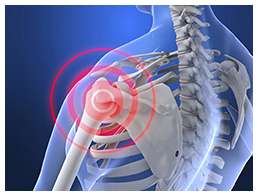 |
|
Joint injuries
A joint in the body is simply anywhere that 2 (or more) bones meet each other. Obvious examples of this would be the hip, knee and shoulder joint but there are actually over 300 joints in total within the human body. All of these joints are held together with different structures such as ligaments or connective tissue and all of these joints have other specialised structures within them to help provide stability and aid in movement of those bones. Why is this important? Well...all of the structures within or surrounding a joint are susceptible to injury and can be a cause of pain or dysfunction within that joint. An injury to a joint is most often referred to as a "joint sprain."
Joint sprains can vary in severity, but generally will be classed as 1 of 3 grades. These are:
- Grade 1 - minor straining of the ligament. Pain levels and swelling are very minor if at all present. May require (but not always) up to 1 week's rest from sport/activity.
- Grade 2 - significant, but not full tearing of the ligament. Pain levels and swelling will be moderate to large and bruising may become visible. This type of injury will most likely require time away from sport/activity and appropriate treatment to allow recovery and appropriate healing of the ligament.
- Grade 3 - full disruption of the ligament(s). This is the most serious case of joint sprain. Interestingly, pain levels, while initially quite severe, may not be as bad as a grade 2 sprain. This is because the nerve supply to the ligament has also been completely torn, so there is no pain signal reaching your brain to let you know there is damage to the ligament. In a lot of cases grade 3 sprains will require surgery to repair the damaged ligaments.
As physiotherapists, we are experts in assessing and diagnosing joint sprains throughout the body, meaning we will be able to properly ascertain what structures have been injured and to what degree that injury is. With this, we can come up with a treatment plan that will allow full recovery from that injury. This plan could involve hands on treatment, strapping/taping, exercises to rehabilitate the muscles and nerves of that joint or potentially referral on to a surgeon if the injury is severe enough.
Examples of common joint injuries:
- Ankle sprain from rolling ankle:
- Ankle sprains are fairly common, however if not rehabilitated correctly at the first instance, this condition can occur again and again leading to serious issues within that ankle. It is always a good idea to have the ankle checked after a sprain to start a rehabilitation programme that will aim to prevent the injury reoccurring.
- Acute wry neck (stiff neck):
- Sometimes a joint within the neck can become stuck or “locked” and requires the aid of a physiotherapist to free the movement. This condition can be quite painful but is generally very responsive to good quality treatment.
- Knee ligament sprain/rupture:
- Commonly in sport or in certain workplaces, the knee joint is put under very heavy strain and sometimes the ligaments within them can fail. Appropriate assessment within the first few days in vital to ascertain the severity of the condition (ie the grade of the tear) and to formulate a plan to start recovery. If left for too long, the knee joint will suffer and may not be able to ever fully recover.
- Knee meniscus tear:
- A meniscus is a special piece of cartilage that exists within the knee and helps to cushion the knee from the stress it undergoes when walking, running and jumping. Certain twisting movements at the knee (such as changing direction while running) can put stress through the menisci, leading to tearing of these structures. Pain and swelling within the joint will occur in these situations and treatment will be required to reduce these symptoms. Surgery can be an option to help with this condition in extreme cases, which your physiotherapist can help to advise you on.
- Shoulder dislocation:
- Dislocations of the shoulder (or any joint for that matter) can be very painful and debilitating. A dislocation will be the result of a forceful trauma (such as falling onto an outstretch arm) where the ligaments or other stabilising structures have been ruptured, meaning that the bones are no longer held together and thus will separate. Immediate care is required to safely put the joint back in place (best done at the emergency department in a hospital). Following this, physiotherapy will be able to help reduce pain and improve range of movement and strength. Surgical options may also need to be looked into depending on certain factors which your physiotherapist will look thoroughly at.
↑ Back to Top
For more information on the conditions we treat and services we offer, or to book an appointment please call (03)9790 4266 or email: [email protected]
|
|

| We are a preferred provider for MediBank Private and BUPA clients, meaning patients with these private health funds will receive discounts at our clinic |
|
|
 |